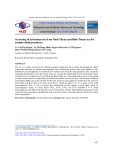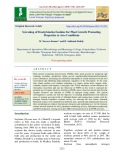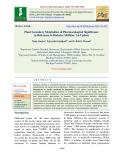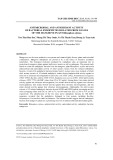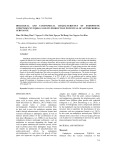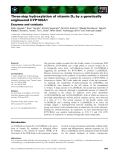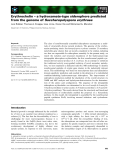
Produce biologically active secondary metabolites
-
The sea is a unique ecosystem for finding secondary metabolites from marine microorganisms. Many compounds produced by marine microorganisms with antibacterial activity have been applied in life. Furthermore, microorganisms are renewable raw materials and media for drug production, thus crucial for sustainable development in our life.
 10p
10p  vicaptainmarvel
vicaptainmarvel
 21-04-2023
21-04-2023
 6
6
 3
3
 Download
Download
-
Plant growth promoting rhizo-bacteria (PGPR) affect plant growth by producing and releasing secondary metabolites (plant growth regulators/phytohormones/biologically active substances), facilitating the availability and uptake of certain nutrients from the root environment and inhibiting plant pathogenic organisms in the rhizosphere. At the same time, plants produce root exudates containing e.g. sugars, amino acids, organic acids, vitamins, enzymes and organic or inorganic ions.
 6p
6p  angicungduoc5
angicungduoc5
 12-06-2020
12-06-2020
 16
16
 0
0
 Download
Download
-
Diabetes mellitus is a metabolic disorder characterized by hyperglycemia and alterations in carbohydrate, fat and protein metabolisms. Diabetes is associated with absolute or relative deficiencies in insulin secretion by pancreatic β-cells and/or insulin action. For the treatment of diabetes large numbers of herbal preparations are in vogue. Plant cells produced secondary metabolites which are biologically active constituents with therapeutic and prophylactic applications in humans.
 40p
40p  kequaidan4
kequaidan4
 05-05-2020
05-05-2020
 14
14
 1
1
 Download
Download
-
Mangroves are the most productive ecosystems and contain highly diverse plants and microbial communities. Mangrove endophytes are proved to be a rich source of bioactive secondary metabolites. The biological molecules produced by endophytes play an important role in protection of mangrove plants against herbivores, insects as well as pathogens. The present study aimed to isolate the endophytic bacteria from the mangrove plant Rhizophora stylosa and screen antimicrobial and antioxidant activity of ethyl acetate extracts from the isolated endophytic bacteria.
 9p
9p  12120609
12120609
 23-03-2020
23-03-2020
 19
19
 1
1
 Download
Download
-
Endophytic actinomycetes colonize in living plant tissues without causing harm to the host plant. In fact, they are regarded as effective bio-control agents and plant growth promoters due to their ability to activate plant self-immunity and produce biologically active secondary metabolites. Recent studies reported higher rates in finding new strains and antimicrobial substances among endophytes than actinomycetes from soil and plant surface.
 8p
8p  nguyenhong1235
nguyenhong1235
 28-11-2018
28-11-2018
 45
45
 1
1
 Download
Download
-
Our previous studies revealed that the double variant of cytochrome P450 (CYP)105A1, R73V⁄R84A, has a high ability to convert vitamin D3 to its biologically active form, 1a,25-dihydroxyvitamin D3 [1a,25(OH)2D3 ], suggesting the possibility for R73V⁄R84A to produce 1a,25(OH)2D3 . BecauseActinomycetes, including Streptomyces, exhibit properties that have potential advantages in the synthesis of secondary metabolites of industrial and medical importance
 11p
11p  viettel02
viettel02
 19-02-2013
19-02-2013
 35
35
 1
1
 Download
Download
-
The class of nonribosomally assembled siderophores encompasses a multi-tude of structurally diverse natural products. The genome of the erythro-mycin-producing strainSaccharopolyspora erythraeacontains 25 secondary metabolite gene clusters that are mostly considered to be orphan, including two that are responsible for siderophore assembly.
 14p
14p  mobifone23
mobifone23
 18-01-2013
18-01-2013
 44
44
 2
2
 Download
Download
CHỦ ĐỀ BẠN MUỐN TÌM








